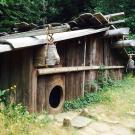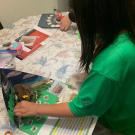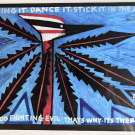HSS 5.1.2,
HSS 5.3.5,
Connecting—Anchor Standard 11,
1.VA:RE7.1,
5.VA:RE7.1,
6.VA:RE7.1,
8.VA:RE7.1,
PROF.VA:RE7.1
This lesson introduces students to the concept of art as a powerful tool for storytelling, cultural identity, and historical reflection through the work of Native California artist, Frank LaPena (Nomtipom Wintu). Students will explore how Native artists act as “culture bearers,” sharing community traditions, beliefs, and experiences through visual expression. By examining LaPena’s artwork, students will learn how images can communicate ideas, preserve oral traditions, and honor tribal geographies and ceremonies.
The lesson supports students in developing visual literacy by analyzing how LaPena used bold forms, traditional stories, sacred figures, and natural landmarks—like Mt. Shasta—to express a worldview rooted in Native cultural values. Through class discussion, vocabulary building, and reflection, students will consider how LaPena’s artistic choices speak to both resilience and historical trauma, including themes of identity, spiritual belief, and the enduring presence of Native peoples in California. The lesson culminates in opportunities for students to connect their own lives to the themes of memory, tradition, and place.
This lesson deepens students' understanding of California history by centering Native voices and recognizing the significance of Indigenous perspectives in shaping both past and present. In doing so, the lesson encourages respectful engagement with Native California cultures while fostering empathy, critical thinking, and cultural awareness.





